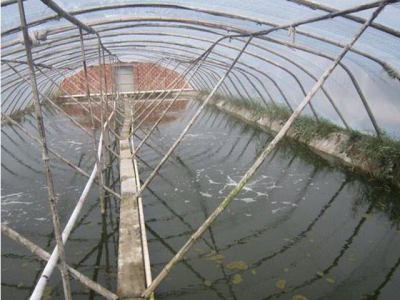Regional authorities in China move to close 40,000 shrimp ponds

Authorities in Jiangsu Province’s recently issued a notice to “quit shrimp or close down” to the owners of up to 40,000 polytunnel-style covered shrimp ponds.
Photo courtesy of Shuishui Aquatic Products
The notice was published in local media in the Nantong region of Jiangsu Province and signed by the local government agricultural, water, and environment bureaus. Tighter enforcement of environmental regulations has seen wholesale closures of aquaculture facilities in sensitive shoreline, wetland, and reservoir areas around China this year, with a resultant inflationary impact on prices for some species.
Nantong is located in the Yangtze River delta, the focus of an intensified environmental clean-up campaign in recent years. The authorities are blaming the pollution of local freshwater sources on vannemei farmers, citing excessive amounts of inorganic nitrogen and phosphorus found in local water bodies.
This is the latest in a series of stand-offs between shrimp farmers and government in Nantong, revealing the pressure on China’s aquaculture sector has come under from the enforcement of stricter environmental laws.
The Nantong notice warns that the operators of shrimp farms that don’t shut down will be fined up to CNY 1 million (USD 143,600, EUR 126,100). Nantong’s shrimp farmers have been advised to switch to farming other aquatic species such as carp and loach that have a lower environmental impact. However, that’s hardly an enticing prospect for farmers who claim to have invested up to CNY 20,000 (USD 2,870, EUR 2,520) per shed to produce vannemei.
This summer, shrimp farmers in Nantong were offered CNY 5 (USD 0.72, EUR 0.63) per square meter in compensation for each of their shrimp sheds and ponds. A note from local authorities in August offering the compensation also notified shrimp farmers that the electricity to their facilities would be cut.
But the shrimp farmers claim that government encouraged investment in shrimp facilities in 2014 and are seeking higher compensation, in addition to guarantees on new land. A combined force of police, military police, and “chen guan” – an urban uniformed inspectorate tasked with public order and civic tidiness – forced the removal of roadblocks put in place by farmers in August to prevent the removal of the shrimp facilities.
The Nantong incidents also illustrate the lack of a strong voice for the sector in China, where seafood industry bodies are state-funded and sponsored.
Related news
 A review of unit processes in RAS systems
A review of unit processes in RAS systems This column reviewed important unit processes in recirculating aquaculture system design and began to discuss components used to remove waste solids
 What to do about EMS/AHPN?
What to do about EMS/AHPN? A number of commonalities have been observed among occurrences of early mortality syndrome (EMS) or acute hepatopancreatic necrosis (AHPN) in shrimp
 Ecuador's Sustainable Shrimp Partnership moves forward with creating shrimp-farming standar
Ecuador's Sustainable Shrimp Partnership moves forward with creating shrimp-farming standar The Sustainable Shrimp Partnership, an Ecuador-based certification system for shrimp aquaculture launched in March 2018, is pushing forward with developing